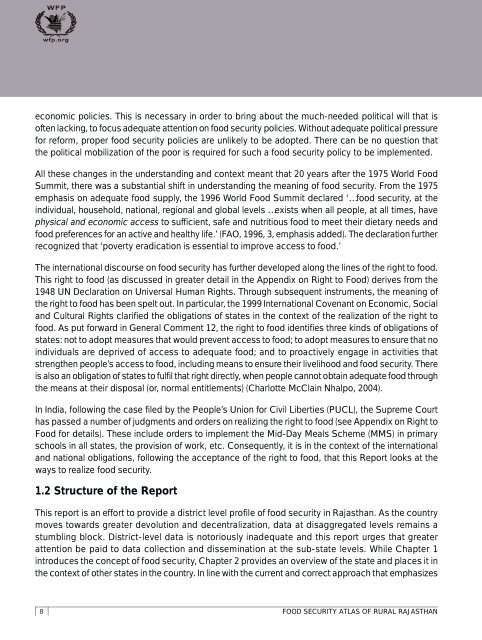Download PDF - ReliefWeb
Download PDF - ReliefWeb
Download PDF - ReliefWeb
Create successful ePaper yourself
Turn your PDF publications into a flip-book with our unique Google optimized e-Paper software.
economic policies. This is necessary in order to bring about the much-needed political will that is<br />
often lacking, to focus adequate attention on food security policies. Without adequate political pressure<br />
for reform, proper food security policies are unlikely to be adopted. There can be no question that<br />
the political mobilization of the poor is required for such a food security policy to be implemented.<br />
All these changes in the understanding and context meant that 20 years after the 1975 World Food<br />
Summit, there was a substantial shift in understanding the meaning of food security. From the 1975<br />
emphasis on adequate food supply, the 1996 World Food Summit declared ‘…food security, at the<br />
individual, household, national, regional and global levels …exists when all people, at all times, have<br />
physical and economic access to sufficient, safe and nutritious food to meet their dietary needs and<br />
food preferences for an active and healthy life.’ (FAO, 1996, 3, emphasis added). The declaration further<br />
recognized that ‘poverty eradication is essential to improve access to food.’<br />
The international discourse on food security has further developed along the lines of the right to food.<br />
This right to food (as discussed in greater detail in the Appendix on Right to Food) derives from the<br />
1948 UN Declaration on Universal Human Rights. Through subsequent instruments, the meaning of<br />
the right to food has been spelt out. In particular, the 1999 International Covenant on Economic, Social<br />
and Cultural Rights clarified the obligations of states in the context of the realization of the right to<br />
food. As put forward in General Comment 12, the right to food identifies three kinds of obligations of<br />
states: not to adopt measures that would prevent access to food; to adopt measures to ensure that no<br />
individuals are deprived of access to adequate food; and to proactively engage in activities that<br />
strengthen people’s access to food, including means to ensure their livelihood and food security. There<br />
is also an obligation of states to fulfil that right directly, when people cannot obtain adequate food through<br />
the means at their disposal (or, normal entitlements) (Charlotte McClain Nhalpo, 2004).<br />
In India, following the case filed by the People’s Union for Civil Liberties (PUCL), the Supreme Court<br />
has passed a number of judgments and orders on realizing the right to food (see Appendix on Right to<br />
Food for details). These include orders to implement the Mid-Day Meals Scheme (MMS) in primary<br />
schools in all states, the provision of work, etc. Consequently, it is in the context of the international<br />
and national obligations, following the acceptance of the right to food, that this Report looks at the<br />
ways to realize food security.<br />
1.2 Structure of the Report<br />
This report is an effort to provide a district level profile of food security in Rajasthan. As the country<br />
moves towards greater devolution and decentralization, data at disaggregated levels remains a<br />
stumbling block. District-level data is notoriously inadequate and this report urges that greater<br />
attention be paid to data collection and dissemination at the sub-state levels. While Chapter 1<br />
introduces the concept of food security, Chapter 2 provides an overview of the state and places it in<br />
the context of other states in the country. In line with the current and correct approach that emphasizes<br />
8 FOOD SECURITY ATLAS OF RURAL RAJASTHAN

















